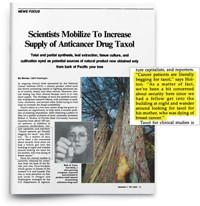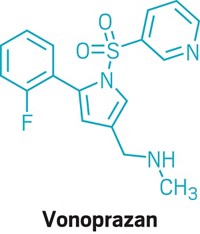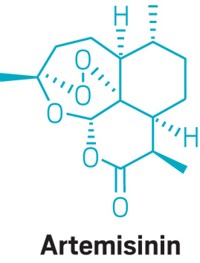Advertisement
Grab your lab coat. Let's get started
Welcome!
Welcome!
Create an account below to get 6 C&EN articles per month, receive newsletters and more - all free.
It seems this is your first time logging in online. Please enter the following information to continue.
As an ACS member you automatically get access to this site. All we need is few more details to create your reading experience.
Not you? Sign in with a different account.
Not you? Sign in with a different account.
ERROR 1
ERROR 1
ERROR 2
ERROR 2
ERROR 2
ERROR 2
ERROR 2
Password and Confirm password must match.
If you have an ACS member number, please enter it here so we can link this account to your membership. (optional)
ERROR 2
ACS values your privacy. By submitting your information, you are gaining access to C&EN and subscribing to our weekly newsletter. We use the information you provide to make your reading experience better, and we will never sell your data to third party members.
Biological Chemistry
Paclitaxel Production Update
November 8, 2010
| A version of this story appeared in
Volume 88, Issue 45
Although a fermentation route to taxadiene is of some interest, “Boosting Taxol Production” is out-of-date in suggesting that this might lead to a breakthrough in the production of paclitaxel (Taxol), which the C&EN article claims “is currently produced by chemically modifying baccatin III, which is isolated from needles of the European yew tree” (C&EN, Oct. 4, page 6). In fact, paclitaxel itself is already produced by an aqueous-based plant cell fermentation (PCF) process.
The story behind Bristol-Myers Squibb’s 2002 decision to discontinue the semisynthetic paclitaxel route and focus solely on the PCF route is detailed in chapter 7 of “Green Chemistry in the Pharmaceutical Industry” (Dunn, P. J. et al., editors. Weinheim: Wiley-VCH, 2010). Using technology licensed from Phyton Biotech GmbH, BMS scientists developed a PCF process using cells cultured from the needles of the Chinese yew tree (Taxus chinensis). Implementation of the PCF process on a commercial scale overcame the many disadvantages of the semisynthetic route, which included the need for large plantations of Taxus baccata, the generation of about 240 metric tons per year of biomass waste from the isolation of the baccatin derivative, and the 11 chemical transformations and seven isolations involved in the conversion to paclitaxel.
In the cell fermentation stage of the PCF process, calluses are propagated in a wholly aqueous medium in large fermenters under controlled conditions at ambient temperature and pressure. The feedstock for cell growth consists of renewable nutrients, sugars, amino acids, vitamins, and trace elements. This impressive example of the application of the principles of green chemistry to an industrial product was recognized by a 2004 Presidential Green Chemistry Challenge Award (C&EN, July 5, 2004, page 4).
Mike Williams
Kent, England





Join the conversation
Contact the reporter
Submit a Letter to the Editor for publication
Engage with us on Twitter